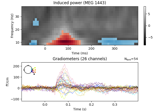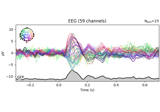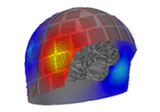mne.pick_channels#
- mne.pick_channels(ch_names, include, exclude=(), ordered=True, *, verbose=None)[source]#
Pick channels by names.
Returns the indices of
ch_namesinincludebut not inexclude.- Parameters:
- ch_names
listofstr List of channels.
- include
listofstr List of channels to include (if empty include all available).
Note
This is to be treated as a set. The order of this list is not used or maintained in
sel.- exclude
listofstr List of channels to exclude (if empty do not exclude any channel). Defaults to [].
- orderedbool
If True (default), ensure that the order of the channels in the modified instance matches the order of
ch_names.New in v0.20.0.
Changed in version 1.7: The default changed from False in 1.6 to True in 1.7.
- verbosebool |
str|int|None Control verbosity of the logging output. If
None, use the default verbosity level. See the logging documentation andmne.verbose()for details. Should only be passed as a keyword argument.
- ch_names
- Returns:
See also
Examples using mne.pick_channels#

Non-parametric 1 sample cluster statistic on single trial power


